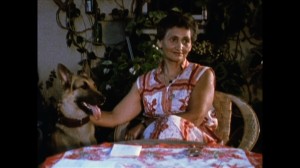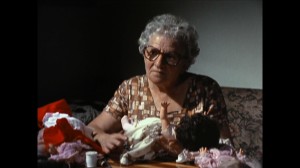
by Amy Stone
A Final “Shoah” Installment Tells Women’s Stories
What’s left for filmmaker Claude Lanzmann to tell us about the Shoah? At his death at 92 this past July, with rare honors at Les Invalides in Paris, he had gone from teenage fighter in the French resistance to the tireless creator of “Shoah,” its 9-plus hours of interviews followed by feature-length spinoffs.
Much of Lanzmann’s work concentrates on men’s stories. Now women are getting the last words. And the telling is in the details. Would these stories have the same impact if they were not part of the Lanzmann canon? I think not. But he showed us a different way of looking at the Shoah. As historian Deborah Lipstadt says, Lanzmann was trying to instill modesty of judgment. We don’t know what we’d do in their place.
When “Shoah” appeared in 1985, twelve years in the making, it revolutionized Holocaust cinematography. Created from 300+ hours of interviews, devoid of death camp footage, “Shoah,” Lanzmann said (as quoted in The New York Times), should not be considered a documentary because “I did not record a reality that pre-existed the film, I had to create that reality” out of “a kind of chorus of emerging voices and faces, of so many killers, victims and bystanders.” He never stopped returning to his interviews with those who had lived through the Shoah, Hebrew for “catastrophe.” (He detested the word “Holocaust,” literally “burnt offering,” and didn’t think much of made-for-Hollywood “Schindler’s List” with its happy ending.)
The day before Lanzmann’s death, his final work, “Shoah: Four Sisters,” was released in France. The four feature-length interviews have just been released in New York and Los Angeles in pairs: “Ruth and Ada,” “Hanna and Paula.” Filmed in the 1970s, the four unrelated women from Poland, Czechoslovakia and Hungary tell their stories of survival as Lanzmann gently probes, cigarette between fingers, sideburns just starting to gray. No dates are given for the filming. These women could’ve been interviewed yesterday.
What we take away is not answers but images and unexpected information. Ruth Elias, thin, elegant, was 17 when the Nazis invaded Ostravia, Czechoslovakia. She was glad to go to Theresienstadt since her boyfriend was there. They married with a borrowed wedding ring and she became pregnant just as the Nazis stopped aborting pregnant prisoners. In Auschwitz, her husband and the rest of her family dead, she carried her pregnancy to term, hiding in a work detail between two other girls. Ruth tells Lanzmann: “I was so young. I wanted to live.” Inner strength? Luck? Who can say.

Her newborn became a Mengele experiment and a Jewish woman doctor (perhaps the gynecologist Gisella Perl) insisted on observing the Hippocratic Oath by offering an end to suffering for the doomed baby. Lanzmann interviewed Ruth in Israel, perhaps on a moshav, with a giant German shepherd at her side and barking dogs in the background. What are we to make of this? What are we to make of her saying, “Israel is my home,” but also saying that when she gave birth there, no one cared that she was a survivor. When she began screaming, she says, they thought she was crazy.
Dolls, piles of dolls, dressed and naked, are the images Lansmann chose for Ada Lichtman. Tortoise shell frame glasses, gray hair, brown print dress, she has needle and thread in hand as she tells her story non-stop. The man by her side listens in anguish, head bent into hand. The naked doll grows in shock value.
Ada’s story starts in Wieliczka, Poland, near Krakow, where the invading Germans  massacred her father and the rest of the Jewish men. She ended up in the Sobibor extermination camp, sewing dresses for the dolls taken from murdered Jewish children. The officers delighted in these little beauties, presents for their own children. Ada recounts being led outside in freezing weather, no coat, only a short-sleeved silk blouse (silk blouse!), wondering if this was how she would die. That tiny detail is just as terrifying as Ada’s saying that she was one of only three to survive the transport of almost 7,000 Jews to Sobibor. But here she is, singing “The Sun Will Come Out.”
massacred her father and the rest of the Jewish men. She ended up in the Sobibor extermination camp, sewing dresses for the dolls taken from murdered Jewish children. The officers delighted in these little beauties, presents for their own children. Ada recounts being led outside in freezing weather, no coat, only a short-sleeved silk blouse (silk blouse!), wondering if this was how she would die. That tiny detail is just as terrifying as Ada’s saying that she was one of only three to survive the transport of almost 7,000 Jews to Sobibor. But here she is, singing “The Sun Will Come Out.”
 For Hanna Marton, from Cluj, Hungary, the dominant image is the small leather-bound notebook she holds. Lanzmann draws out the details of the pact Rezsö Kasztner made with Adolf Eichmann to ransom 1,684 Hungarian Jews, including Hanna and her husband. They didn’t know that hundreds of thousands of Hungarian Jews were being shipped off to Auschwitz. She speaks of Kasztner’s painstaking selection of who would be saved: some Orthodox Jews, a mix of Zionists, a few poor Jews, and, above all, professionals, friends and family – hence the film’s title, “Noah’s Ark.” Did Hanna feel guilt for being spared? Yes. “Why me of all people?” Did her husband? Hanna doesn’t think so. “He was a fatalist.” And her husband recorded it all in daily entries in that elegant little notebook.
For Hanna Marton, from Cluj, Hungary, the dominant image is the small leather-bound notebook she holds. Lanzmann draws out the details of the pact Rezsö Kasztner made with Adolf Eichmann to ransom 1,684 Hungarian Jews, including Hanna and her husband. They didn’t know that hundreds of thousands of Hungarian Jews were being shipped off to Auschwitz. She speaks of Kasztner’s painstaking selection of who would be saved: some Orthodox Jews, a mix of Zionists, a few poor Jews, and, above all, professionals, friends and family – hence the film’s title, “Noah’s Ark.” Did Hanna feel guilt for being spared? Yes. “Why me of all people?” Did her husband? Hanna doesn’t think so. “He was a fatalist.” And her husband recorded it all in daily entries in that elegant little notebook.
 Paula Biren is a surprise. Seated by the ocean, hair and earrings blowing in a breeze, this attractive woman holds her own with Lanzmann. She could be American. She could be a friend. She was 17 when her family was sent to Bałuty, the ghetto in the slums of Lodz, Poland. The gems are in the details, like a training program in the ghetto with students raising goats. She faced the impossible choice of whether to remain a teenage policewoman once she knew her work was helping deport others. Her family relied on her income and without it, they’d be deported. (She didn’t succeed in saving them.) Lanzmann presses her to tell him what the Jewish policemen thought of their job. “Ask them yourself,” she says. Not even Lanzmann could get them—or her—to talk. Maybe there are some things better left unsaid.
Paula Biren is a surprise. Seated by the ocean, hair and earrings blowing in a breeze, this attractive woman holds her own with Lanzmann. She could be American. She could be a friend. She was 17 when her family was sent to Bałuty, the ghetto in the slums of Lodz, Poland. The gems are in the details, like a training program in the ghetto with students raising goats. She faced the impossible choice of whether to remain a teenage policewoman once she knew her work was helping deport others. Her family relied on her income and without it, they’d be deported. (She didn’t succeed in saving them.) Lanzmann presses her to tell him what the Jewish policemen thought of their job. “Ask them yourself,” she says. Not even Lanzmann could get them—or her—to talk. Maybe there are some things better left unsaid.
Viewers of this last installment cannot expect neat chronological narratives or extensive historical information. And don’t expect the official trailer to capture the essence of Lanzmann’s final work. The throbbing music and words of human hope against all odds would work better for “Schindler’s List.” Lanzmann knew the Shoah could not be packaged.
Amy Stone is a founding mother of Lilith magazine.
The views and opinions expressed in this article are the author’s own and do not necessarily reflect those of Lilith Magazine.
